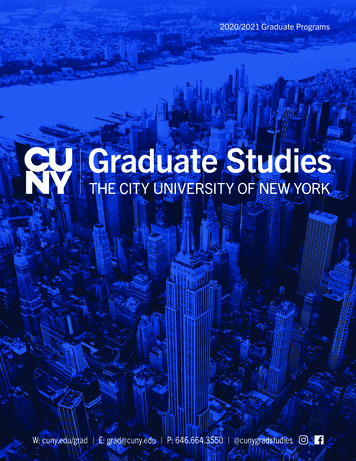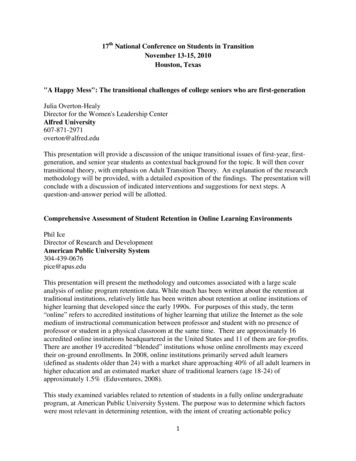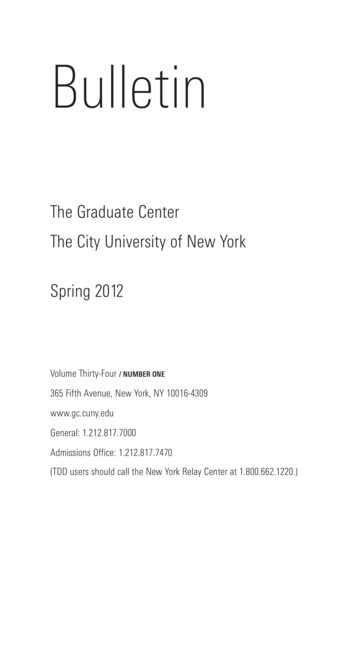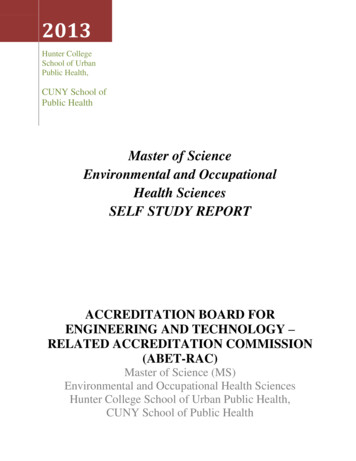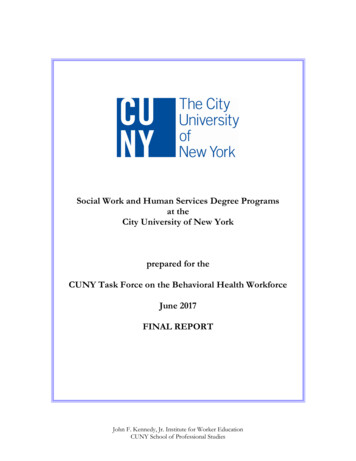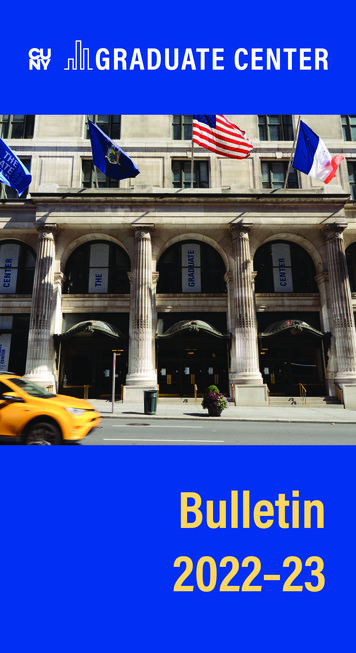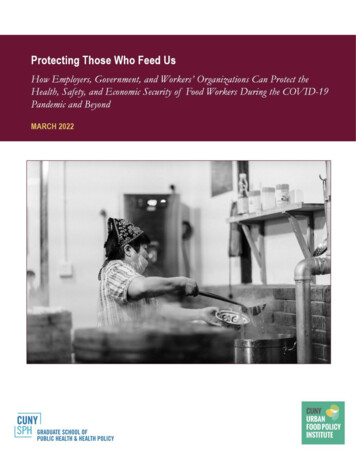
Transcription
CUNY Graduate School of Public Health & Health Policy Urban Food Policy Institute
Protecting Those Who Feed Us ReportAcknowledgementsWe thank the community-based organizations, food businesses, labor unions, worker advocates, andindividual food workers who contributed their time and insights to this project. We also thank theJohnson Family Foundation for its support of this project. Thanks especially to Christina Valeros andGloria Gonzalez Dellatore for their research and analysis at various stages of this project.About the CUNY Urban Food Policy Institute and its Good Food Jobs ProjectsSince its founding in January 2016, the CUNY Urban Food Policy Institute (the “Institute”) (basedat the CUNY Graduate School of Public Health and Health Policy in Harlem, NYC has combinedresearch, teaching, advocacy, and action to solve urban food problems. The Institute providesevidence to inform municipal policies that promote access to healthy, affordable food and a moreequitable and sustainable food system.Thanks to the support of the Johnson Family Foundation, this mission has flourished through ourGood Food Jobs Project (GFJP), which has mapped, nurtured, and seeks to grow good food jobsacross New York City. These jobs, which pay decent wages, offer benefits and career advancement,and contribute to making healthier food more accessible in low-income communities, are a starkcontrast to the reality that many food sector employees face.In 2018, the Institute launched two programs dedicated to the growth of good food jobs. First, AGuide to Growing Good Food Jobs in New York City highlighted the work of Community DevelopmentCorporations (CDCs) and Settlement Houses (SHs), identifying models for integrating workforcedevelopment and healthy food access. We identified five models for this integration and exploredtheir potential for cultivating good food jobs: (1) Youth Development and Food; (2) InstitutionalFood; (3) Food Retail Workforce; (4) Community Chefs; and (5) Food Business Incubators. We alsoidentified a need for academic and training programs that would offer a pathway to food sector work.Therefore, we also launched in 2018 the Good Food Jobs Training Program (GFJTP). The GFJTPprovided youth ages 18-24 with culinary and job readiness training, preparing students for good foodjobs careers.In 2020 and 2021, the Institute partnered with the Laurie M. Tisch Center for Food, Education &Policy at Teachers College and the New York City Food Policy Center at Hunter College to conducta comprehensive assessment of the impact of the COVID-19 pandemic on the food system, includingon food workers, in New York City. This year the Institute begins a project to explore how CUNYcan better support and advance the careers of its many students working in the food sector.Suggested citation: Chong, Valerie Peter; James, Charita Johnson; Fraser, Katherine Tomaino; Brown,Rhonda; Ignacio, Karla; Willingham, Craig; Cohen, Nevin; and Freudenberg, Nicholas. Protecting Those WhoFeed Us: How Employers, Government, and Workers’ Organizations Can Protect the Health, Safety, and Economic Securityof Food Workers During the COVID-19 Pandemic and Beyond. CUNY Urban Food Policy Institute, March 2022.Cover image credit: Steve Long, Unsplash2
CUNY Graduate School of Public Health & Health Policy Urban Food Policy InstituteExecutive SummaryThe COVID-19 pandemic has devastated communities within New York City, across theUnited States, and throughout the world, but its effects have been particularly challenging for“essential workers,” individuals whose labor was necessary for the continued functioning ofeveryday life [1]. Throughout the pandemic, these workers were expected to continue to showup to their jobs. While all essential workers faced risks from traveling to and from work andas a result of exposure to possibly infected co-workers and customers, food workers inparticular faced significant risks to their health and safety. This workforce, largely composedof women, immigrants, and people of color, has historically received low wages, inconsistenthours, little opportunity for advancement, and few benefits [2,3,4].To comprehensively document this unparalleled moment in history and to elevate the diversevoices of the NYC food system, Institute researchers collected data from three sources: An online survey of more than 100 frontline NYC food workers Interviews with 10 key stakeholders, including staff of labor unions, food businesses,and community-based organizations that support the NYC food workforce A literature review of more than 100 relevant news and research articles highlightingthe working conditions of food workers in NYC during the pandemic.Key Takeaways Essential workers had trouble obtaining unemployment benefits and were unable to leave their jobs ifthey felt unsafe.City, state, and federal governments provided limited guidance regarding COVID safety practices.Therefore, most workers lacked access to a full range of protections.Though food workers had access to paid sick leave, many were hesitant to use it. At the same time,fewer than half of surveyed workers reported quarantine mandates or exposure alerts by theiremployers.The mental toll of COVID-19 on NYC food workers was just as heavy as the physical health effects.Almost every surveyed worker reported elevated levels of job-related stress during the pandemic.More food workers are unionizing, and public approval of labor unions is up, creating futureopportunities to better protect these workers.Food sector employers are currently experiencing a labor shortage. Meanwhile, food workers areasking for increased wages and benefits, including health insurance and childcare, to recover fromCOVID-19 and sustain their lives.The NYC food workforce is composed mostly of people of color and immigrants, and the Black LivesMatter movement has increased the public’s awareness of racial inequities,including those present in the food industry. Companies are increasingly launching anti-racist andDiversity, Equity, and Inclusion (DEI) initiatives.1
Protecting Those Who Feed Us ReportIntroductionNew York’s food sector has more than 40,000 food businesses employing approximately500,000 workers [4]. While more than half of these workers are restaurant employees [5], otherfood sector laborers perform a wide variety of jobs, from cashiering at grocery stores to sellingfood from street carts to working in large warehouses as packers. The businesses they workfor are mostly small and independently owned, compared to other cities which rely on nationalchains [4]. This workforce, largely composed of women and people of color, has historicallyreceived low wages, inconsistent hours, little opportunity for advancement, and few benefits[2,3,4]. The industry, particularly the food service sector, has also faced significant issues ofoccupational segregation. Women and Black and Latinx workers are often paid less for thesame position as their white male counterparts or are not selected for higher-paying jobs suchas restaurant servers or bartenders due to racial bias [6,7,8].By April 2020 the unemployment rate rose to 14.8% nationally, the highest it had been inrecent history [9]. By June, NYC’s unemployment rate had exceeded the national rate, withworkers of color facing far higher unemployment rates than their white counterparts [10].21.1% of Asian, 23.7% of Black, and 22.7% of Latinx New Yorkers were out of workcompared to 13.9% of white residents [11]. NYC’s restaurants, a booming industry thatprovided more than 300,000 jobs pre-pandemic, faced COVID-related safety restrictions thatcut the workforce by more than 70% [5]. Yet due to federal guidance regarding essential criticalinfrastructure workers [1], many food sector employees were required to continue working.While workers took pride in being “essential,” particularly at the beginning of the pandemic,for many this feeling was replaced over time with stress and fears of contracting COVID asthe pandemic progressed. As one union representative said in an interview,“You will find the same (food worker) who felt this empowerment, being so essential and soimportant to keep your food on the table.started to experience more stress as they began feelingignored.There were still fears and risks of contracting the virus and getting coworkers sick andworst of all, going home and getting everyone you live with sick and potentially dying. (Workers)felt like the general public did not think of them as essential workers anymore.”For many employees, the health risks required to maintain one’s income resulted in a drop inmorale, especially when the public began to take for granted that frontline workers would beon the job. Workers who quit during this time had trouble obtaining unemployment insurancedue to their essential status, because unlike those furloughed or laid off due to the economicfallout of the pandemic, essential workers who left their jobs due to fears of safety weredeemed to have quit voluntarily [12]. At the same time, workplace protections to mitigate riskof COVID exposure were often inadequate. Mandates regarding mask-wearing, socialdistancing, quarantining, and other safety measures were often in flux, leading to confusion,disagreement, and a feeling of endangerment. Early in the pandemic, the food industry wasone of the hardest hit by PPE shortages, and some grocery store managers even refused toallow workers to wear masks and gloves, believing that doing so would panic customers[13,14,15].2
CUNY Graduate School of Public Health & Health Policy Urban Food Policy InstituteImage credit, dapiki moto, UnsplashIn the midst of the pandemic, the murder of George Floyd in May 2020 served as a catalystfor many anti-racist demonstrations across the country and brought new attention to the starkracial inequities in food worker pay, benefits, working conditions, and health and safety. Insome cases, food workers and their organizations joined the mobilizations launched by BlackLives Matter, adding urgency and power to the campaigns initiated to protect food workersfrom COVID. For example, Los Deliveristas Unidos, a group of primarily Latinx food deliveryworkers, organized against a lack of protections that denied them the same rights as theworkers employed by the restaurants they delivered from. Considered independentcontractors, food delivery workers were prevented from using restaurant bathrooms orhandwashing stations [16].Additionally, many workers felt that they were paid insufficiently and even reported that theirtips were stolen by the companies that employed them [17]. Los Deliveristas organized rallies inthe wake of the Black Lives Matter protests, and their efforts led the New York City Councilto introduce a new legislative package for these “gig workers” [18]. Now, restaurants arerequired to allow food delivery workers to use the bathroom, and delivery apps are requiredto offer minimum payments per trip and provide workers with receipts to avoid wage theft[19].Prior to the pandemic, the #MeToo movement called attention to the sexual harassment anddiscrimination experienced by women workers. With many female workers and many small3
Protecting Those Who Feed Us Reportbusinesses where laws against gender discrimination were more difficult to enforce, the foodsector faced high rates of these problems.In June 2021, more than a year after the initial stay-at-home order, the Occupational Safetyand Health Administration (OSHA) released an emergency temporary standard (ETS)requiring employers to comply with strict workplace safety protocols [20]. The new standardsset by this ETS included employer-provided PPE, mask mandates, cleaning and ventilationstandards, COVID-19 screening protocols, social distancing requirements, notification ofCOVID exposure, and paid sick time for employees who tested positive, were exposed, orwere getting vaccinated. However, these OSHA guidelines applied only to employees in thehealthcare sector, despite the efforts of food worker advocacy groups and unions to have themapply to all frontline workers.When the COVID-19 pandemic hit, the call to improve employment opportunities, wages,and working conditions for food laborers was stronger than ever. So too was the need toidentify the unique challenges exacerbated by the crisis. Faced with this task, Instituteresearchers sought to answer the following questions:1. What are food businesses, especially those employing low-wage workers, doing to protect theirworkers during the pandemic and beyond?2. What are city, state, and federal agencies doing to protect the health and safety and economicsecurity of these workers?3. What are workers organizations, labor unions, and other such organizations doing to protectthe health and safety and job security of these workers?4. What more could businesses, government, and labor organizations do to address issues of health,safety, and economic security of food workers?To answer these questions, we gathered information from three sources: an online survey ofmore than 100 frontline NYC food workers, interviews with key stakeholders, including staffof labor unions, food businesses, and community-based organizations that support the NYCfood workforce, and a review of relevant news coverage and more than 50 research articleshighlighting the working conditions of food workers in NYC during the COVID-19pandemic. Further details about these methods are provided in Appendix A.Based on an analysis of our findings, this guide describes positive innovations developed byemployers, government agencies, and worker organizations in response to the pandemic andthe subsequent economic crisis, as well as problems that require more effectiveresponses. The guide aims to connect readers in the food system to organizations and agenciesthat can provide support on job safety, mental health, food security, financial security, andother issues.4
CUNY Graduate School of Public Health & Health Policy Urban Food Policy InstituteWhat major challenges have food workers faced during COVID-19?Our recent survey of more than 100 food workers in NYC uncovered various challenges theseindividuals experienced at work during the pandemic. Most survey respondents acknowledgedthat they were entitled to paid sick leave through legislation by New York State and Citygovernments (See “A History of Paid Sick Leave in NYC”). Yet, many of these frontline foodworkers reported that they were hesitant to take time off from work due to illness or to carefor a sick loved one. Early in the pandemic, sick workers- most of them uninsured- struggledto obtain COVID tests or doctor’s notes, and employers retaliated against workers who couldnot provide proof of illness [24].Union representatives participating in our stakeholder interviews shared that one of thecompanies whose workers they represent would purposely avoid disclosing COVID-19exposure with employees. The worry was that exposed workers would also request paid sicktime to quarantine, and the business would have to temporarily close. They also explained thatthe Just Cause Law, a ruling preventing termination without reason, was only recently passedand only protected fast food workers [25].A History of Paid Sick Leave in NYC2014: All private employers with 5 or more employees must provide up to 40 hours of paid sick leave. Domesticworkers (home care workers, house cleaners, etc.) and small businesses (4 or fewer employees) are exempt.Leave is accrued at a rate of 1 hour per 30 hours worked [21].2021: Domestic workers must now be provided with 40 hours of paid sick leave. NYS law requires smallbusinesses with a net income of 1 million or more to provide paid leave and employers with 100 or moreemployees must provide up to 56 hours of paid leave [22].NYS Emergency COVID-19 Paid Sick Leave Law: All public and private sector workers ordered to quarantine areentitled to sick leave paid by the employer in addition to accrued sick leave as outlined above. Workers may alsoget additional paid leave for COVID-19 vaccination [23].In fact, our survey results found, 29% of supply chain, 17% of emergency food distribution13% of retail, and 9% of fast-food workers stated that if they didn’t come to work while sick,they would lose their jobs. These groups also reported high levels of stress, as shown in Figure1. Overall, app-based delivery (100%), emergency food distribution (83%), institutional foodservice (78%), and fast food (73%) workers faced the highest levels of COVID-related stressamong those surveyed.5
Protecting Those Who Feed Us ReportFigure 1. Job-Related Stress Compared to Pre-COVID by Food Sector Identified in Survey Responses100%90%80%70%60%50%40%30%20%10%0%Much LessSomewhat LessSame Stress LevelSomewhat MoreAgricultureRetailFarmers MarketFast FoodSupply ChainEmergency Food DistributionInstitutional Food ServiceRestaurantsApp-Based DeliveryFood ProductionMuch MoreOur findings also highlighted inconsistencies in COVID safety protocols. Almost every foodsector expert we interviewed shared frustrations about the lack of clarity and consensus fromthe city, state, and federal government on COVID safety recommendations. As shown inTable 1, the food workers we surveyed were asked to share which COVID-19 mitigationprotocols were implemented at their places of work. Notably, most respondents reported thatthe safety measures that were in place were well-enforced by management; however, they alsonoted that the full range of CDC recommended protocols were not implemented by themajority of NYC food businesses [26]. Measures such as regular testing, exposure alerts, andquarantine mandates were identified as being implemented by fewer than half of respondents.6
CUNY Graduate School of Public Health & Health Policy Urban Food Policy InstituteTable 1. COVID-19 Safety Measures Identified in Survey ResponsesCOVID Safety MeasurePPE ProvidedClean and Disinfect More OftenSocial DistancingHand Sanitizer StationSafety RemindersImplement More Rigid Cleaning ProtocolLimit Amount of People Allowed into BusinessScreen Employees’ Temperatures and SymptomsEnforced Quarantine MandatesTake Patrons’ TemperaturesTraining/Education of Safety ProtocolsExposure AlertsProtective Barriers/DividersAdditional Handwashing StationsRegular COVID TestingImagecredit: Uriel Mont, PexelscreditPercent of Survey Respondents who Identifiedthis Measure in their %11%The majority of NYC’s restaurant workers werefurloughed when the pandemic hit [5]. These serviceworkers, largely dependent on tips for their wages, havehistorically faced barriers to accessing unemploymentinsurance. Before COVID, service workers had the lowestrate of unemployment benefit use out of any occupation[27]. High rates of wage theft and under-reported cash tipsmean that these workers often do not meet the minimumwage requirement set by New York State [28]. Asrestrictions slowly lifted and businesses reopened,restaurant workers were mandated to return to work orlose what unemployment insurance they were able toreceive, as those who voluntarily quit their jobs do notqualify for the federal benefit [8,12]. Yet the majority ofthese same workers also faced a 50% reduction in their tips,significantly reduced hours (often 10 hours a week or less),and lackluster COVID-19 risk mitigation protocols [8]. Infact, 71% of Black tipped workers reported that customersreduced their7
Protecting Those Who Feed Us Reporttips when the workers enforced safety guidelines, leading many to have to choose betweentheir safety and their income [29]. And the risk to health and safety was significant. Across thegeneral US population, Black and Latinx individuals were almost three times as likely to behospitalized for COVID-19 infection and twice as likely to die from the virus [30].What protections and supports have been most beneficial?Stakeholders from B Corp food businesses, for-profit companies that consider the impact oftheir businesses on their workers, customers, suppliers, community, and the environment [31],community-based organizations, labor unions, and emergency food distribution groupshighlighted some of the best protections in the sector. Not only did these groups describeprotective equipment and other basic safety measures provided to employees to keep infectionrates as low as possible, many highlighted less common and more innovative measures. Theseincluded implementation of new “COVID Czar” roles, individuals who stay up to date on thelatest COVID safety recommendations and ensure that these recommendations areimplemented, temporary business closures, purchasing additional culinary tools to discouragesharing that might spread germs, and using “incident badges” which sense when a staffmember is too close to another and records the interaction for contact tracing purposes.Interviewees of organizations with COVID Czars listed more protective measures introducedto their organizations than those without the position.Interviewees also reflected on financial incentives provided to workers during this difficultperiod. These included “unofficial” hazard pay, such as permanent wage increases, gift cards,emergency funds, and free MetroCards or ride sharing app trips. One organization, a culinarytraining program, had to suspend in-person classes and rapidly adapted to virtualprogramming. Fully online, staff held financial coaching sessions and provided assistance withunemployment, SNAP, and other benefit enrollment applications. They also set up andpromoted a fundraiser to distribute emergency funds to their students. Finally, this companypartnered with an organization to provide free or low-cost health care regardless of insurancestatus. It is important to note that the majority of food businesses, such as groceries andrestaurants, have not had this opportunity to go virtual. However, all workers could potentiallybenefit from essential needs resources.Caring food organizations have also provided new mental health resources in the wake ofCOVID-19, including more comprehensive mental health coverage within existing healthinsurance packages, free counseling services for workers, resource guides, and classes such asmeditation sessions. These businesses also combatted low morale by encouraging teambuilding initiatives, such as group check-ins. One respondent said that for their team ofemergency food distributors, “the program kept us alive.” The organization, composed mostly ofvolunteers, gave workers a sense of purpose and human connection.Finally, the growing awareness of the Black Lives Matter movement prompted manybusinesses to examine how their practices perpetuate White Supremacy. Said one stakeholder,8
CUNY Graduate School of Public Health & Health Policy Urban Food Policy Institute“Last spring a lot was going on including the pandemic, the murder of George Floyd, and the corporate reckoningwith Black Lives Matter and that movement.It's hard to talk about one without the other, they're veryintertwined.” Exemplary food organizations have launched anti-racist initiatives and DiversityEquity and Inclusion (DEI) measures. Some have also contracted external racial equityconsultants to audit their businesses and provide recommendations.Looking ahead, what challenges remain? What do food workers need most from their employersto recover from the pandemic?The COVID-19 pandemic is not over, other pandemics may emerge in the future, and foodworkers continue to serve in low-paying, insecure jobs. Survey respondents were asked toprovide their opinions of what workers in the food sector need most in the short term torecover from the impact of COVID-19. Answers varied, but the most common responseinvolved increased income, whether from a permanent pay raise, increased hours, hazard pay,or another stimulus check. Said one respondent, “I believe if we are given higher pay we would be ableto work harder and love our jobs more.”Improved health and safety measures were the second most common response, suggestingthat though those COVID risk mitigation protocols highlighted in Table 1 were reportedlywell-enforced, many workers would have liked more consistent and thorough safety measures,such as enforced quarantines and exposure alerts.New trends suggest that many food sector workers are transitioning to new fields. Accordingto One Fair Wage, more than half of New York State’s restaurant workers are consideringleaving the industry entirely because of low wages and health risks, especially as tipped foodworkers make subminimum wages [32]. As an employee of a culinary training program in NYCnoted, "How can we ethically and reasonably tell people to join a sector that's not going to treat them well or(give them the) opportunity to grow and make the wages they want to make in order to support their families?"One clear way to mitigate the growing labor shortage is to provide workers with living wagesand competitive benefits. Large chains, like McDonald’s and Chipotle, are raising hourly wages[33], but health insurance and other essential benefits are largely being ignored. Childcare is asignificant need for food workers. With children home from school due to COVID, this needbecame even more significant. Childcare costs can amount to half or more of a minimum wageworker’s paycheck, leading many to wonder whether staying home is a better option.Employer-paid stipends or universal free or subsidized childcare alleviate this pressure.Collective bargaining efforts may also become more common. While most food sectoremployees do not belong to labor unions, more and more workers have been organizing. Inthe US, support for labor unions is the highest it’s been since 2003 [34], and unionrepresentatives are noting that in the wake of COVID-19, there is more bargaining potentialthan ever before. Labor union SEIU Local 32BJ was a crucial actor in the fight for fooddelivery workers’ rights alongside Los Deliveristas Unidos [16]. Additionally, our survey results9
Protecting Those Who Feed Us Reporthighlighted in Figure 1 suggest that food production workers- a group with a high rate of laborunion membership- experienced less job-related stress during the pandemic than other sectors.Image credit: Jon Tyson, UnsplashBased on our findings, we recommend that food sector employers looking to improve thesafety, wellbeing, and financial security of their staff take the following steps, in tandem withsupporting the policy recommendations highlighted in the next section:1. Provide workers with a living wage. A 15 minimum wage is not enough to sustainthe average New Yorker, and the risk of exposure to illness- including but not limited toCOVID-19- should be compensated. We recommend that employers use the MIT LivingWage Calculator, referenced in our Resources section below, to determine fair wages for staff.2. Offer employees a competitive benefits package, including healthinsurance. Get ahead of the worker shortage and inspire employee loyalty by compensatingyour workers' essential labor with comprehensive benefits. We also recommend supportingadvocacy efforts for universal healthcare which will remove the burden from employers to providethis essential benefit.3. Communicate paid sick leave policy and encourage its use. New York Cityand State law requires most food businesses to offer 40 hours of paid sick leave for employers10
CUNY Graduate School of Public Health & Health Policy Urban Food Policy Institutewith fewer than 100 employees and 56 hours for businesses with 100 or more employees [23].However, our findings suggest that food sector workers have been hesitant to use these allottedhours. We recommend that employers clearly communicate the rights of their workers to use paidsick leave, and encourage workers to use the time they have accumulated. Labor laws are onlyuseful if workers believe that their employers will follow them and that they will not lose theirjobs in the process. By opening a dialogue about labor rights within the workplace, employerscan foster trust and ensure compliance with the law.4. Communicate clearly and enforce strictly recommended health and safetymeasures. Though OSHA’s new emergency temporary standard (ETS) applies only tohealthcare workers, we encourage food sector employers to use the guidance as a model for theirown businesses. This includes providing PPE, requiring masks, social distancing, adhering tosanitizing and ventilation standards, screening employees and patrons for COVID-19, andnotifying all employees of COVID exposures. Remember, COVID-19 may not be the lastpublic health crisis in our lifetimes, so continue to evaluate and modify these measures over time.5. Support the essential security and mental health needs of employees.Actively share resources, including those promoting SNAP enrollment, low-cost healthcare, andaffordable housing with employees. Additionally, both survey and interview respondents agreedthat the emotional ramifications of the pandemic, including the fear of being unable to stay homewhen ill, were just as hard-hitting as the physical health effects. The significant workplace stresslevels experienced by food sector workers can be mitigated by providing workers with mentalhealth resources and other supports, like group discussions and team building events. See belowfor a more comprehensive list of resources.6. Encourage labor union membership. With public approval of labor unions higherthan it has been in nearly two decades [34], employers increasingly recognize the value of unions.Union representation bridges the gap between administration and workers, and our researchsuggests that union membership may mitigate workplace stress. An organized workforce alsoexperiences less turnover, a benefit for both workers and managers.7. Mandate anti-racism training for staff and develop robust diversity andinclusion guidelines. The food workforce is largely
About the CUNY Urban Food Policy Institute and its Good Food Jobs Projects Since its founding in January 2016, the CUNY Urban Food Policy Institute (the "Institute") (based at the CUNY Graduate School of Public Health and Health Policy in Harlem, NYC has combined research, teaching, advocacy, and action to solve urban food problems.
